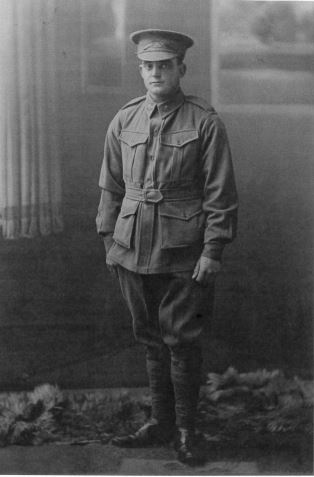Pte
Marshall James Slater
Information about birth
|
Year of birth: 1889 |
|
Place of birth: Thebarton, South Australia, Australia |
General information
|
Profession: Labourer |
Army information
|
Country: Australia |
|
Force: Australian Imperial Force |
|
Rank: Private |
|
Service number: 386 |
|
Enlistment date: 07/01/1916 |
|
Enlistment place: Adelaide, South Australia, Australia |
|
Units: — Australian Infantry, 43rd Bn. (The Hindmarsh Regiment) (Last known unit) |
Information about death
|
Date of death: 17/10/1917 |
|
Place of death: Seine, Zonnebeke, Belgium |
|
Cause of death: Killed in action (K.I.A.) |
|
Age: 28 |
Memorial
|
Ypres (Menin Gate) Memorial Panel: 27V |
Distinctions and medals 2
|
British War Medal Medal — 20/05/1922 |
|
Victory Medal Medal — 20/05/1922 |
Points of interest 3
| #1 | Place of birth | ||
| #2 | Enlistment place | ||
| #3 | Place of death (approximate) |
My story
In the morning of the 12th of October 1917 the 3rd Australian Division attacked in conjunction with the 4th Australia Division on the right and the New Zealanders on the left. The 11th Brigade was in reserve for the 3rd Australian Division, as it already has seen action on the 4th of October. During the attack of the 12th of October the 43rd Battalion was held up at Bremen Redoubt. Their first position was in close vicinity of an artillery battery. The Battalion chose to leave this position in favor of Bremen Redoubt, because the battery was frequently shelled by the Germans. They remained at Bremen Redoubt for over 26 hours.
The attack of the 12th wasn’t a success and the 11th Brigade again moved forward to its old sector, occupying the same dispositions as before the attack. In the morning of the 13th of October the Battalion relieved a portion of the 9th Brigade. The 43rd manned the defences in the vicinity of Tyne Cot. The Battalion Headquarters were located at Seine. The Battalion remained at Tyne Cot until the 15th of October.
After 48 hours in the lines near Tyne Cot the Battalion was relieved by men of the 9th Brigade. The 43rd went back to reserve and took up positions between Seine and Beecham, where it would remain for six days. The positions between Seine and Beecham were frequently shelled by the German artillery. Although the 43rd were considered to be dug in deep, the frequent shelling made casualties each day. We believe Private Marshall James Slater was one of the men of the 43rd Australian Division who was killed in action due to the heavy shelling at the Australian positions between Seine and Beecham. He was killed on the 17th of October.
The attack of the 12th wasn’t a success and the 11th Brigade again moved forward to its old sector, occupying the same dispositions as before the attack. In the morning of the 13th of October the Battalion relieved a portion of the 9th Brigade. The 43rd manned the defences in the vicinity of Tyne Cot. The Battalion Headquarters were located at Seine. The Battalion remained at Tyne Cot until the 15th of October.
After 48 hours in the lines near Tyne Cot the Battalion was relieved by men of the 9th Brigade. The 43rd went back to reserve and took up positions between Seine and Beecham, where it would remain for six days. The positions between Seine and Beecham were frequently shelled by the German artillery. Although the 43rd were considered to be dug in deep, the frequent shelling made casualties each day. We believe Private Marshall James Slater was one of the men of the 43rd Australian Division who was killed in action due to the heavy shelling at the Australian positions between Seine and Beecham. He was killed on the 17th of October.
Sources 4
|
43rd Infantry Battalion (Australian War Memorial, Campbell, (AWM), AWM4 23/60). https://www.awm.gov.au/ Sources used |
|
Colliver M.C. and Richardson B.H., 43rd Bn Unit History: 'The boys went magnificently'" (Adelaide, Rigby Limited Publishers, 1920), pg. 53-62. Sources used |
|
First Australian Imperial Force Personnel Dossiers, 1914-1920 (National Archives of Australia, Canberra (NAA), B2455, SLATER M J. http://recordsearch.naa.gov.au Sources used |
|
McCarthy C., The Third Ypres Passchendaele. The Day-by-Day Account (London, Arms & Armour Press, 1995), pg. 113-119. Sources used |
More information 4
|
Commonwealth War Graves Commission Database https://www.cwgc.org/find-records/find-war-dead/casualty-details/1601134 |
|
Namenlijst (In Flanders Fields Museum) https://namenlijst.org/publicsearch/#/person/_id=f6a5b94c-025a-4b7c-99a7-77260e039ec7 |
|
Lives of the First World War (Imperial War Museum) https://livesofthefirstworldwar.iwm.org.uk/lifestory/7589979 |
|
The AIF Project (UNSW Canberra) https://aif.adfa.edu.au/showPerson?pid=276962 |
